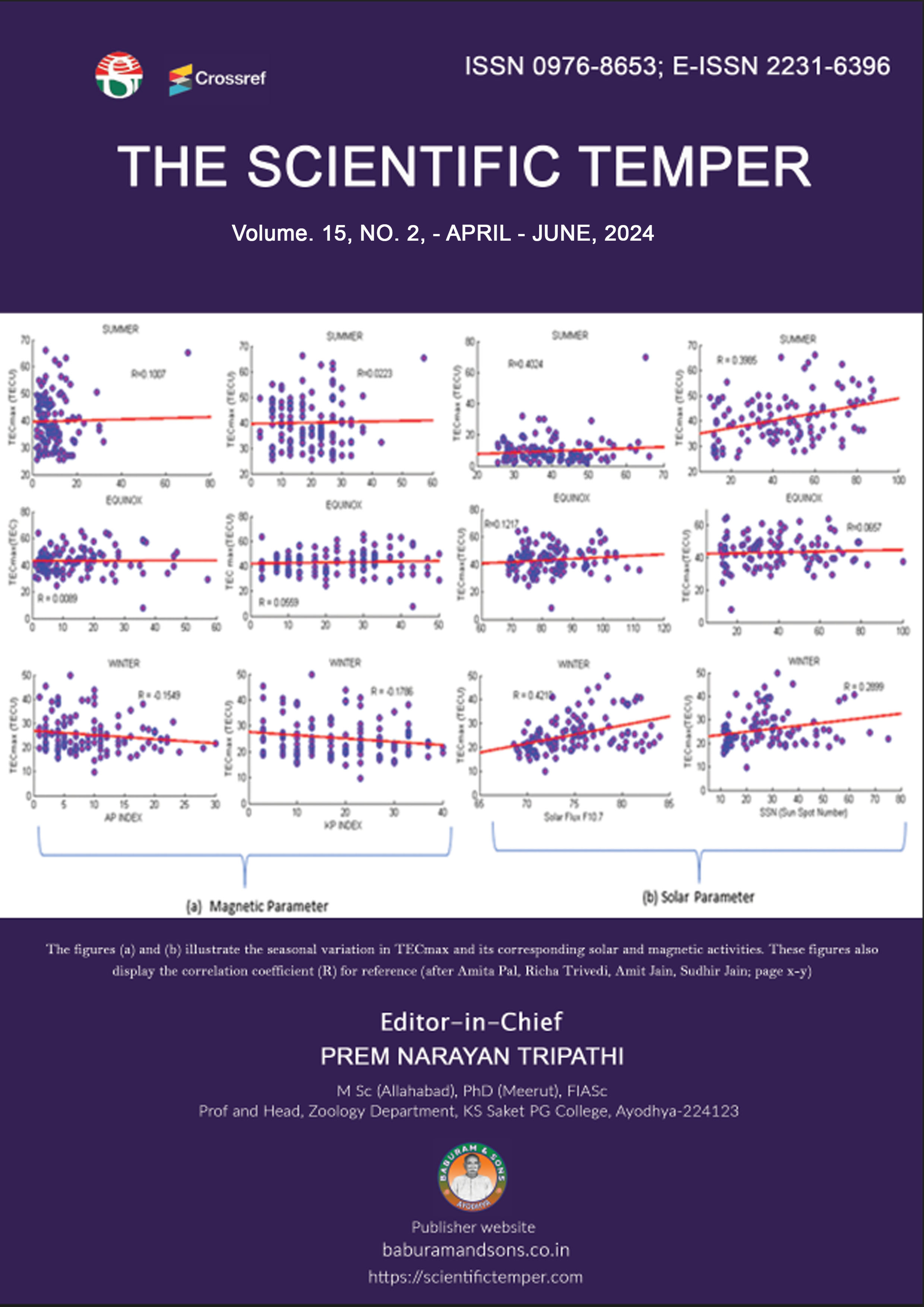Evaluation of white seeded sesame (Sesamum indicium L.) genotypes on growth and yield performance in Menit Goldya Woreda of West Omo Zone, SWE
Downloads
Published
DOI:
https://doi.org/10.58414/SCIENTIFICTEMPER.2024.15.2.46Keywords:
cropping seasons Genotypes (varieties), Location, sesame, yield, yield componentsDimensions Badge
Issue
Section
License
Copyright (c) 2024 The Scientific Temper

This work is licensed under a Creative Commons Attribution-NonCommercial-ShareAlike 4.0 International License.
Sesame is the second export crop next to coffee in annual export, indicating the highest 14% of the total world export of the crop. In Africa, Sudan is the major sesame producer, followed by Nigeria, Somalia, Uganda and Ethiopia. But lack of well-adapted varieties are one of the bottleneck production problems that account for low yield and small areas cropped to the nation. Thus it is essential to evaluate such genotypes, which have high yield potential and are suitable to local environmental conditions. Therefore, field experiments were conducted at west Omo zone during 2019/20 main cropping seasons at one location of West- the Omo zone, southwest Ethiopia. The location was Menit Goldiya districts of West Omo Zone, through evaluation and selection of high-yielding sesame varieties. The study comprised of five improved and one local sesame varieties laid out in RCBD with three replications at each location. The growth and yield data were collected and analyzed by using SAS Version 9.3 statistical software. The result of the study revealed that all of the parameters considered were significantly (p < 0.01) affected by varieties on both years. Accordingly, at Menit Goldiya for, all parameters in both years and the combined analysis over the years indicated that maximum plant height, number of primary branches per plant, number of capsules per plant, thousand seed weights in grams and seed yield were observed for the Humera-1 variety. Likewise, the shortest days to flowering, early maturing, the highest length of capsule bearing zone, the maximum number of capsules per plant, the highest number of seeds per capsule and the maximum seed yield (8.13 Qu/ha) were observed for the Humera-1 variety in 2019/2020 growing seasons. Based on the mean total seed yield of locations and different yield evaluation methods, a high-yielding variety was identified. Accordingly, the Humera-1 variety performed best on both years. Therefore, this variety can play a vital role in food self-sufficiency and food security of the south-western region and it should be widely distributed to farmers of the testing locations and similar areas of the region.Abstract
How to Cite
Downloads
Similar Articles
- V. Mahalakshmi, M. Manimekalai, Location Specific Paddy Yield Prediction using Monte Carlo Simulation incorporated Long Short-Term Memory , The Scientific Temper: Vol. 16 No. 10 (2025): The Scientific Temper
- Anita M, Shakila S, Stochastic kernelized discriminant extreme learning machine classifier for big data predictive analytics , The Scientific Temper: Vol. 15 No. spl-1 (2024): The Scientific Temper
- Rajesh Kumar Singh, Genetic Variability in Aromatic Rice , The Scientific Temper: Vol. 13 No. 02 (2022): The Scientific Temper
- R. P. Singh, R. Chandra, Bikramaditya ., Efficacy of Phosphorus and PSB Response in Different Varieties of Summer Moongbean and Its Residual Effect on Fodder Sorghum in Western Uttar Pradesh , The Scientific Temper: Vol. 11 No. 1&2 (2020): The Scientific Temper
- S K Bairagi, Ram Chandra, R P Singh, Effect of Different Phosphorus and Potassium Levels on a Seed Crop of French Bean (Phaseolus vulgaris L.) , The Scientific Temper: Vol. 12 No. 1&2 (2021): The Scientific Temper
- P.L. Parmar, P.M George, Effect of process parameters on concentricity in CNC turning operation using design of experiment , The Scientific Temper: Vol. 15 No. 04 (2024): The Scientific Temper
- M. Menaha, J. Lavanya, Crop yield prediction in diverse environmental conditions using ensemble learning , The Scientific Temper: Vol. 15 No. 03 (2024): The Scientific Temper
- Aditi Sahariya, Chellapilla Bharadwaj, Iwuala Emmanuel, Afroz Alam, Phytochemical Profiling and GCMS Analysis of Two Different Varieties of Barley (Hordeum vulgare L.) Under Fluoride Stress , The Scientific Temper: Vol. 12 No. 1&2 (2021): The Scientific Temper
- U.S.P. Sinha, R. Chakravorty, STUDIES ON THE PHOSPHATIC AND POTASSIC FERTILIZERS REQUIREMENT OF MULBERRY (Morus alba L.) BASED ON SOIL TEST VALUES , The Scientific Temper: Vol. 1 No. 01 (2010): The Scientific Temper
- R. P. Singh, R. Chandra, Bikrmaditya ., Effect of Nipping on Growth and Yield of Chickpea (Cicer Aritinum L.) Under Dryland Condition , The Scientific Temper: Vol. 12 No. 1&2 (2021): The Scientific Temper
<< < 1 2 3 4 5 6 7 8 9 10 > >>
You may also start an advanced similarity search for this article.



